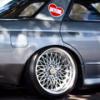Cam Lift Low-down
Announcements
-
Similar Content
-
Latest Posts
-
Great work! Thanks for documenting the process.
-
By joshuaho96 · Posted
How would you even adjust the clutch if the pedal already has the correct free play? The operating cylinder has no adjustment in mounting position or rod length. On pull style clutches there is also no ability to adjust the bearing carrier. Push type I can see how adjusting the carrier height makes it all work. If this is the twin plate clutch did you verify that your friction disks were oriented correctly? It's not mentioned in the directions at all you just have to notice that one side the friction disks have a part number on the hub fingers and a subtle coning to those fingers. Another thing that I noticed was if you put the friction disks in backwards the pressure plate fingers will not be even and flat when the clutch is installed. -
price drop $1000 gbox $400 clutch
-
yeah, mechanically, it is probably do-able, off the top of my head, there would be the transfer case, which I believe will bolt up to the rear of the RWD transmission, the shorter rear tail shaft. A front drive shaft, front diff, engine upper sump, front drive shafts, front hubs and front AWD struts (they are shaped around the front drive shafts), LCAs (at the very least from the front suspension) oil cooler. You might want the rear diff from an AWD too, so you can be certain the front and rear diff rations are identical. Who knows what brackets and mounts you might need. So a whole doner car might be the best option if you need to maintain RHD. Then actually making it work, that would be a whole different story.
-
Take the fall as a warning sign for future endeavours Stay safe mate
-








Recommended Posts
Create an account or sign in to comment
You need to be a member in order to leave a comment
Create an account
Sign up for a new account in our community. It's easy!
Register a new accountSign in
Already have an account? Sign in here.
Sign In Now